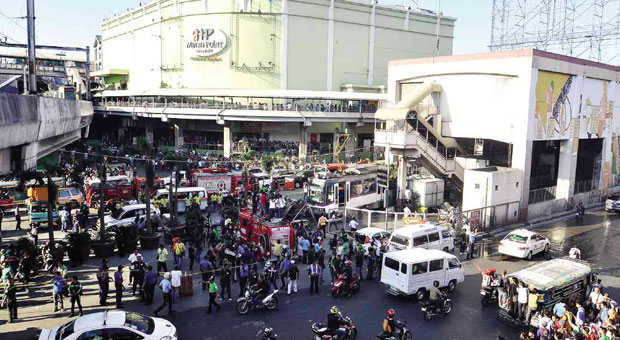
THE BIG MESSY PICTURE The runaway MRT train (encircled) juts out of Taft Station in Pasay City after coming off the tracks and breaking through the barriers on Wednesday. RICHARD REYES
MANILA, Philippines–Metro Rail Transit (MRT) riders can blame the entire system—or just narrow it down to James Duque and Heigen Villacarlos.
The two MRT drivers are the focus of the police investigation into Wednesday afternoon’s train derailment that sent at least 38 people to the hospital for injuries and raised new questions about the safety of the congested 15-year-old line on Edsa.
Malacañang and the Senate have also called for a thorough inquiry that could again put MRT officials on the spot, but it would be up to the Pasay City police whether anyone would actually be charged.
Around 4 p.m. on Wednesday, a stalled southbound MRT train overshot the railway and broke through the barrier of the Taft Avenue station, after being given a push by an operational train. The first train went out of control after the coupling connecting the two trains broke.
Chief Insp. Angelito de Juan, head of the investigation division of the Pasay police, said the probe was focusing on the possible negligence on the part of Duque and Villacarlos or a third party whose lapses or misjudgment led to the accident.
In his statement to the police on Thursday, Duque, the driver of the train that went off-rail, said his train earlier stalled because it was operating “under voltage” or with insufficient power, a problem which he immediately relayed to the MRT control center.
He later received instructions to “initialize” or restart the train but it failed to do so despite his repeated attempts.
Duque was then informed by the control center that a “rescue train”—the one driven by Villacarlos—would help his train move.
For his part, Villacarlos told investigators that he was instructed to first unload all his passengers at the Magallanes Station so he could come to Duque’s aid.
Who did what?
Both drivers said it was Villacarlos who attached the coupling between the two trains while Duque was the one who released the brake actuator of the defective train as instructed by the command center.
Villacarlos recalled that while he was pushing the train from the Magallanes Station to Taft at a speed of 5 to 10 kph, he suddenly felt a jolt and noticed that the coupling was already detached.
Duque said he did all that was possible to prevent his train from smashing into the station barrier but the brake actuator and the emergency button of the train were no longer operational at that point.
“I just told the passengers over the microphone to hold on to the hand railings inside the train,” Duque said in his statement.
Both Duque and Villacarlos have been driving MRT trains for six years.
Transport chief: MRT still safe
Chief Inspector De Juan said the investigation would try to find out, for example, why an unloaded train had to push “a loaded and much heavier train.”
“We still have to consider a lot of things and coordinate with the MRT administration since we do not know if the decisions made by the drivers were standard operating procedures,” he told the Inquirer Thursday.
Meanwhile, Transportation Secretary Joseph Abaya said his agency was conducting an internal investigation into the matter, but maintained that the MRT remained safe.
In a press conference, Abaya said the probe would determine if human error or a mechanical defect was to blame.
MRT officer in charge Honorito Chaneco said “normal” operations had resumed—with 20 trains running—although “slower” at the Taft area because of the accident.
Abaya took exception to criticism that the Aug. 13 derailment was an accident waiting to happen in view of MRT’s recurring breakdowns and long overdue expansion to cope with the half-million riders that use it daily.
“If I believed that, I would have shut it down,” Abaya said. “For me, safety is important. Why would I even entertain a 100-percent accident scenario?”
“It’s a balance between safety and rendering service—that is a continuing judgment that we continue to do,” he added.
According to De Juan, at least one family of injured passengers had given a statement to the police but had yet to decide whether they would file a formal complaint.
But for one victim, 61-year-old Remigio Dasalla, legal actions may no longer be necessary.
“It was an accident that nobody wanted to happen,” said Dasalla, who was treated at Pasay City General Hospital for a head concussion. He said the MRT administration had paid for his medical bills and promised to extend additional assistance.
“But even without that promise, I have already decided that I will not file a complaint,” he said. “Things like that happen but the accident will not prevent me from riding the MRT again since it is still an affordable and fast way to travel.”

